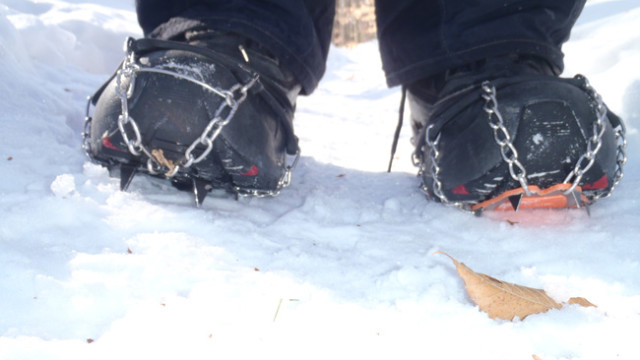The Need For Trail Traction Aids
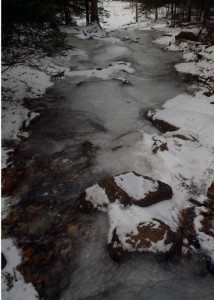
The winter of 2014/15 in the northeast saw little snow after the Thanksgiving Storm and lots of melting, re-freezing and “rain events”, sometimes at sub-freezing temperatures until well into the New Year. Snow, where any remained, was often heavily crusted. And, no matter where we went, from driveway to mountaintop, there was ice; sometimes in spots, sometimes in sheets, or sometimes in winding rivers. Most places in the northeast had so little snow and so much crust that traction aids were more useful overall for hiking than snowshoes.
If the snow isn’t deep, you don’t need the “float” that snowshoes provide, but you often need the extra traction. Even on snow-covered trails, snowshoe and foot traffic can compact the snow into a solid, slippery sheet, which sometimes melts and refreezes into a slick crust. And, of course freezing rain can create pure hell in no time at all. Traction aids won’t always save you if you make a too-risky choice (the hiker who slid over the Headwall and died in Mount Washington’s Tuckerman Ravine in January, 2012 was wearing crampons, yet he somehow stumbled or slipped). But they can sure reduce your risk of slipping and getting hurt in many more common circumstances.
Sadly, the weather and snow conditions are never really predictable in the northeast, especially around the “edges of winter” in December and March. That’s why we all rely so heavily on trail traction aids.
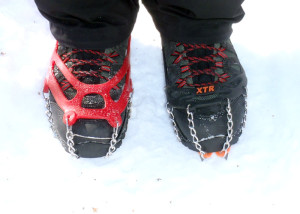
How We Tested Trail Traction Aids
To be honest, it hasn’t taken a lot of extra effort to test the variety of trail traction aids on the market today. Anytime we head outdoors in the winter, we always have a pair with us, and it’s quite remarkable how often we’ll use them in the natural course of scaling windswept mountains, hiking icy trills, or even trekking across the vast barrens of ski area parking lots. And that doesn’t even account for getting the mail, walking down the street for takeout Chinese, and snow blowing our driveways.
However, some of the more interesting tidbits about the performance of various trail traction aids has come when we simply put one brand on one foot and another on the other foot and went on with our plans. That’s how we found out that one brand will handle deeper snow on top of the ice, one has a more solid feel, and another will shed sticky snow more readily.
Traction Choices
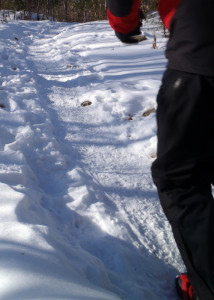
There are many tractions aids on the market and not all are created equal. We are only going to review the ones we’ve actually used on a variety of terrain and in a variety of conditions and found to be useful, and we are going to list them in order of the amount of traction they provide, from sidewalk creepers to just short of full-on mountaineering crampons. We hope this approach will allow you to hit “the sweet spot” for your needs.
The question becomes: how much traction do you need? The answer, of course, is just enough, no more. The wrong choice can be too little traction; or, at the other end of the spectrum, you can LOSE traction with an aggressive traction aid on the wrong surface. With traction aids, as with anything else in outdoors gear, there are factors to be balanced, tradeoffs to be made. Fortunately, there are lots of options these days, so you can find what you need for whatever trail you travel—even if it’s just the path to your mailbox.
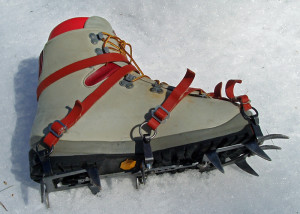
The one category we WON’T be covering is full-on mountaineering and ice-climbing crampons. The conditions where those are necessary are so specialized that, if you’re considering them, you need instruction at a level we can’t provide here (or at all; you need avalanche certification, for starters). And, the crampons themselves can be dangerous; it’s easy to trip and fall with such long spikes, or to stab yourself in the calf with the toe spikes, potentially incapacitating yourself. You can even fall with them attached to your pack, and stab yourself or a companion . Know your limits; if you’re considering these things, take mountaineering or ice climbing classes with EMS, IME, or another climbing school.
Trail Traction Aids: Ice Creepers
At the low end of the traction scale, there are simple, lightweight creepers that will slip onto street shoes or running shoes easily. These work best on bare ice and relatively flat surfaces. They tend to be pretty inexpensive, as well, and there are worse ideas than taking them into the backcountry if you don’t have anything better; just be careful to not trust them TOO much.
YakTrax
Yaktrax, with a patent for their coil-type traction device that goes back to the 20th century, is the elder statesman for the category . While the basic Walk is a good choice for city sidewalks, it was clear to us immediately that the heavier-duty Yaktrax Pro was a better all-around design; the thicker coils are more durable and provide more traction. The instep strap holds them more securely to all footwear. With a retail price of $30, they’re reasonably priced and very functional. The downside is that with no sharp points, they don’t grab ice on an incline well; they’re better suited to flattish trails.
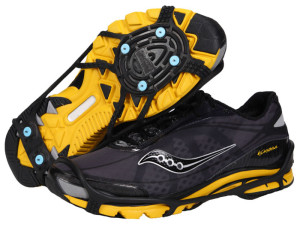
Due North Everyday
One of our editors keeps a pair of Due North Everyday Traction Aids on a pair of slip-on boots all winter for the long trek down his rural driveway to the mailbox each day. The 6 short tungsten spikes on each foot are just enough to provided safety on a flat, plowed surface that frequently turns to blue ice as packed snow melts and re-freezes. If there’s even a dusting of loose snow over the ice, however, these don’t provide much (if any) additional traction.
IceTrekkers Diamond Grip
ICETrekkers Diamond Grip Traction Cleats have little spiked beads that rotate on steel cables to dig their multiple points in to the ice. And, they work…with a couple of caveats. The first one is that we found that when our boots had particularly hard soles (think mountaineering boots), or were on particularly hard surfaces (ice covered granite rocks or your garage floor), they had a tendency to roll on us; we never actually fell down, but everyone who tested them reported that feeling of having to “catch” themselves a number of times. The feeling was, well, disconcerting. We can’t recommend these for the backcountry use due to those issues. On softer soles, we noticed some wear caused by the little metal rollers gouging into the soles with each step. It wasn’t horrible, but it’s a factor.
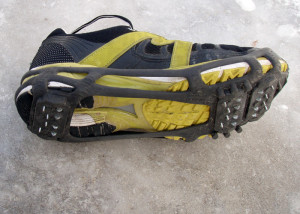
Stabilicers Walk
Like the others in this category, the Stabilicers Walk does its best work on clean, flat ice and hard packed snow. We often keep a pair in the car, just in case. They are cheap, light and far better than nothing. The 24 “cleats” on each foot are small and rounded and buffered by some rubber knobs. They are less likely than others to slip on a hard surface like the concrete floor of your garage, and less likely to do damage if you forget and wear them indoors. They also come in a “Hike” version with an added instep strap, but for most applications, the “Walk” version is probably adequate. We haven’t noticed any problems with them slipping off in the conditions for which they were designed.
Trail Traction Aids: Trail Crampons/Microspikes
The main problem with all the traction aids mentioned so far is that anything more than a dusting of snow on top of the ice can compress under your foot and keep the spring coils, chains or tiny spikes from getting a grip on the ice. So you slip on the snow on top of the ice instead of slipping on the ice. Slanted ice or, worse, slanted ice covered with snow is even more problematic. You can’t even really dig into seriously compacted snow that hasn’t quite turned to ice with them. Realistically, if you’re going to get out into the backcountry, you SHOULD have something more serious.
“Trail crampons” is a broad category that covers from microspikes to almost-full-on mountaineering crampons. MICROspikes is actually a Kahtoola trademark, but we’ve heard dozens of people refer to what’s on their feet by that term, so we’re using it, all lower case, to define a category that includes stretchy frames that pull onto your shoes, chains that hold everything together, and triangular teeth that look like they came from the Bumble in “Rudolph”. These are overall the closest thing to an all-around solution for most winter hikers; the balance of light weight, ease of use, traction, and compact portability means that you are more likely to have these with you when you need them than more “serious” options. That’s the single MOST important factor in traction devices; if they’re in your gear closet and you’re on the trail, they’re bloody useless!
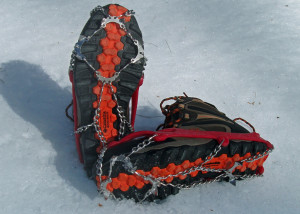
Kahtoola MICROspikes
Kahtoola pioneered the category and, for the past several years, all of us here at EasternSlopes.com have used Kahtoola MICROspikes (14.4 oz/pair), which have a heavy-duty polymer rubber harness that’s easy to put on and grips tightly, and hardened chains with 12 three-eighths-inch steel spikes. They’re fast and easy to put on, and there’s enough stretch in the rubber that the same pair that goes onto our winter hiking boots will also stretch onto our AT boots for when we take off the skis to hike to a summit. Reliable, durable, and moderately priced, these have been, and continue to be, the “go-to” for many of our testers. Negatives? The small plates that the spikes are on allow for the spikes to move independently, which can be a good thing for shedding snow, but on a boot with a softer sole causes a “squidgy” feeling. It doesn’t seem to actually harm the traction, but it can be a little unsettling at times.
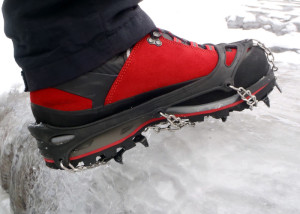
Hillsound Trail Crampons
While Hillsound has several models in this category, we tested the Trail Crampon. These come with an extra instep strap (which can be removed easily), the spikes are slightly longer than the offerings from other companies and the spike attachment is more rigid than the Kahtoolas. Rather than having the spikes mounted on chains, they’re on plates that connect them to each other, with the chains then holding the plates to the harness. The harness has that extra Velcro instep strap, rather than just relying on the stretchy rubber to hold it all in place; depending on the conditions, you have the option of using it or not. The feel of the Hillsounds is distinctly more solid than the Kahtoolas; the plate system keeps the spikes from moving around as much. Testers felt more comfortable on icy downhill stretches with them, as they felt that more spikes were going straight into the snow/ice. Tradeoffs? In wet snow, we had more trouble with snow balling up in the plates; that’s the problem with a rigid setup. If you’re going to use these in snowman-making conditions, be prepared to poke and prod with your pole once in a while, or to stop to take them off and put them back on a few times. One more note of caution: Hillsound’s cleats are not rustproof—clean and dry them after each use, especially if you’ve been near road salt.
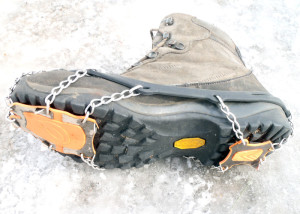
YakTrax XTR Extreme
Even though YakTrax is best known for their coil creepers, they haven’t rested on their laurels, bringing us the Yaktrax XTR Extreme (12.4 oz/pair). It’s an interesting take on the category, with many of the same features as the others (elastomer harness, stainless chains, triangular spikes). Where the XTR sets itself apart is with the cleat plates being bonded to a polymer pad, virtually eliminating the problem of ice balling up in the plates while still allowing the more secure feeling of the cleats being on a solid plate. They’re also lighter and cheaper than the alternatives, being a great value for hikers on a budget (price includes a carry bag, too!). But, all that goodness has its own cost, and it’s in beefiness. The teeth are shorter and lighter gauge; they’ll wear out faster. The chains are also much lighter, and the harness itself is thinner. If you don’t hike a lot in winter, these may be a great choice, but if you’re an abusive beast, the other two options are a better bet.
Trail Traction Aids: Lightweight Hiking Crampons
As mentioned before, if you are taking to the winter mountains where the ice can be steep or even vertical, you need “real” crampons and that’s a different world. If you need that much traction, you’d better have a lot of other skills and equipment to allow you to use them safely; full-on crampons can badly hurt you or your companions. And, they require rigid-soled boots to work correctly. Think of this, too…if you’re in conditions where you need full crampons, you also need avalanche training, beacons, ice axes, ropes and more. They simply aren’t for most winter hikers.
But, there’s an in-between for people who want more than the microspikes can deliver, yet aren’t doing technical climbing. We use them regularly in a variety of situations.
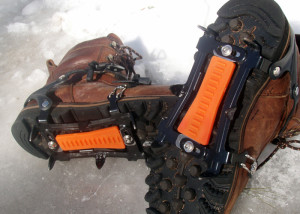
Hillsound Cypress 6 Instep Crampon
The Hillsound Cypress 6 is a category in itself. Simply put,is the best bargain in serious traction available…and that’s its biggest selling point. Let’s talk negatives first…”instep crampon” means “limited steep slope traction.” You get 6 heavy-duty steel spikes that cover from the front of your heel to the ball of your foot. For relatively moderate slopes, that’s fine, but when the going gets steep, the traction is in the wrong place. Going uphill, you need to be able to dig your toe into the slope, and there’s nothing there; all boot, no traction device. It’s a little better going downhill, as long as you’re careful. You can’t heel-toe walk your way down, as there’s no heel traction, but if you place your feet carefully, you can get the rear spikes in. On the positive side, the buckle system makes it rock-solid on your foot, so when you HAVE traction, it’s excellent, and it’s super fast and easy on/off. And, it has an anti-balling plate built in. At half the price, or less, of the other options in this category, it’s a great deal IF it fits your needs. For ice fishermen on snow-covered lakes, this is a no-brainer. Otherwise, evaluate your intended uses carefully before you buy these.
Kahtoola K-10 Hiking Crampon
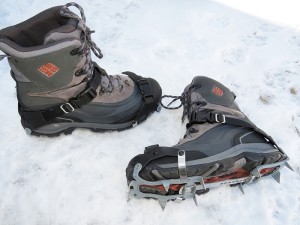
There’s one editor on staff that feels that the Kahtoola K10 Hiking Crampon (22 oz/pair) is the best all-around traction option available…and it’s hard to argue TOO much with him on it. The K-10 has 10 massive triangular spikes, adjusts easily to most boots, has moderate weight, and an easy to use harness (set it to your boots, and it buckles on/off quickly and reliably). It includes snow release skins to help limit ice balling underfoot, and collapses down to a reasonable packing size. It’s moderately priced (current MSRP is $99), and feels secure and stable underfoot. The main tradeoff is the lack of forward-pointed toe spikes for serious scrambling; but if you’re going to do that, you may be starting to creep into full crampon territory and want to reevaluate a whole lot of equipment.
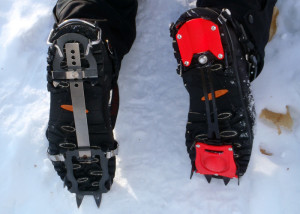
Hillsound Trail Crampon Pro
With 10 long spikes (including two front-facing curved points tucked safely under the toe of your boot), the Hillsound Trail Crampon PRO (24.2 oz./pair) is one step below a full-on technical mountaineering crampon and about as serious as you can get without needing advanced training and skills. It’s comes in several sizes and each is adjustable for a wide range of foot gear. The ratcheting X-style harness fits solidly on almost any boot (including AT and Telemark ski boots). Alone in this category, the Hillsound Trail Crampon Pro has beefy, flexible plastic anti-balling plates heel and toe, which help heel the spikes clear and functional when you get sticky snow on top of crust or ice. At only $79/pair MSRP, these are also a smoking bargain if you need more traction than “microspikes.”
Kahtoola KTS Hiking Crampons
The first of the “hiking” crampons to offer great traction in a less-lethal package than technical mountaineering crampons, the KTS comes in two versions. The lighter KTS Aluminum Crampon is only 19 oz./pair but doesn’t stand up as well to wind-scoured Eastern granite as the KTS Steel Crampon
(23.4 oz/pair). Both are adjustable for length and use the same webbing harness and quick-release buckle system. This has to be pre-set for the boots you are wearing. But, once you’ve done so, they go on easily and stay put. Getting the quick release buckles off when they, and your fingers, are frozen can sometimes be a bit of a challenge. EasternSlopes.com’s executive editor has used his KTS steel crampons for nearly a decade now with no issues, so we’re confident that they’ll survive most users.
Conclusion
So, there you have it. In an ideal world, you’ll have one from each category in your gear closet; that will have you fully prepared for (almost) every traction condition from the sidewalks to the sidehills. If you can only afford one…we’d take one from the “trail crampon” category. Several of us ONLY use those, day in, day out, year in, year out; they’re so flexible in their ability to work in different conditions and on different boots that it’s hard to beat them. One way or another, though, every winter enthusiast should have some sort of traction device with them all the time; you just never know when you’re going to run into conditions where you’ll need them, and you’d hate to miss some fun!


